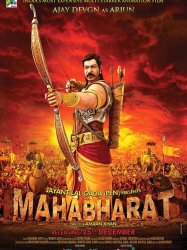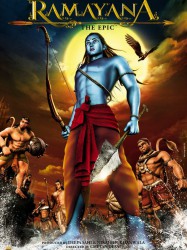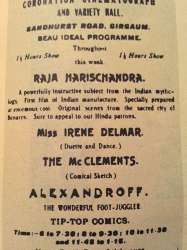Films with theme "Mythologie hindoue", sorted by revenue

Return of Hanuman (2007)
Directed by Anurag Kashyap
Origin Inde
Genres Action, Adventure, Animation
Themes Films about animals, Films based on mythology, Films about religion, Films about apes, Mythologie hindoue, Mise en scène d'un mammifère
Actors Pinky Pal Rajput, Rajendra Gupta, Sudesh Bhonsle
Devas are ’busy’ in their Swarglok (heaven). Technology has crossed boundaries of earth and even non-mortal devas have become techno-geeks. They converse in Hinglish.

The Mahabharata (1989)
Directed by Peter Brook
Origin Portugal
Genres Drama, War
Themes Films about music and musicians, Films based on mythology, Films about religion, Musiques du monde, Musical films, Mythologie hindoue
Actors Andrzej Seweryn, Georges Corraface, Vittorio Mezzogiorno, Bruce Myers, Mallika Sarabhai, Yoshi Oida
In general terms, the story involves epic incidents between two warring families, the Pandavas (representing the good side) and the Kauravas (representing the bad side). Both sides, being the offspring of kings and gods, fight for dominion. They have both been advised by the god Krishna to live in harmony and abstain from the bloody lust for power. Yet their fights come to threaten the very order of the Universe. The plot is framed by a dialogue between the Brahmin sage Vyasa and the Hindu deity Ganesha, and directed towards an unnamed Indian boy who comes to him inquiring about the story of the human race.

Mahabharat (2013)
, 2h5Origin Inde
Genres Action, Adventure, Historical, Animation
Themes Films based on mythology, Films about religion, Mythologie hindoue
Actors Amitabh Bachchan, Ajay Devgn, Vidya Balan, Shatrughan Sinha, Sunny Deol, Anil Kapoor
Le film, suivant l'intrigue de l'épopée, relate le conflit entre deux grandes familles, les Pândava et les Kaurava.

Pandavas: The Five Warriors (2000)
, 1h50Origin Inde
Genres Drama, Action, Adventure, Historical, Animation
Themes Films about magic and magicians, Films based on mythology, Poésie, Films about religion, Mythologie hindoue, Adaptation d'un poème
Based on a classic Indian tale from the Mahabharata, the story depicts the eternal fight between good and evil through the tale of the five Pandavas brothers and their struggles with their cousins, the Kauravas.

Hanuman (2005)
Origin Inde
Genres Fantasy, Adventure, Animation
Themes Films about animals, Films based on mythology, Films about religion, Films about apes, Mythologie hindoue, Mise en scène d'un mammifère
Actors Mukesh Khanna, Sushmita Mukherjee, Pinky Pal Rajput, Rajesh Jolly, Manoj Pandey
This animated movie depicts Hanuman's life from birth. The narrator is actor Mukesh Khanna. The movie relays how Hanuman was born to Anjani (a female Apsara) and Kesari, by the blessings of Vayu-Dev, the Wind God. Hanuman, who is the 11th rudra avatar of Shiva was blessed with supreme intelligence, strength and divine powers. As a baby, Hanuman was quite naughty and used his powers to pester the saints living in the nearby forest. Once when he was hungry, he leapt to catch the sun thinking it was a fruit.

Bal Ganesh (2007)
Origin Inde
Genres Adventure, Musical, Animation
Themes Films about music and musicians, Films based on mythology, Films about religion, Musical films, Mythologie hindoue
Actors Kailash Kher, Asha Bhosle

Dashavatar (2008)
Origin Inde
Genres Adventure, Musical, Animation
Themes Films about music and musicians, Films based on mythology, Films about religion, Musical films, Mythologie hindoue
Actors Tom Alter, Sachin Khedekar, Shreya Ghoshal, Shreyas Talpade, Ashish Vidyarthi, Shankar Mahadevan
The concept of Dashavatara (Ten Avatars) has religious significance. Evil has been present during the evolution of mankind and the Dashavatar have been constantly present to triumph over evil. The most famous incarnations of Vishnu are Rama, whose life is depicted in the Ramayana, and Krishna, whose is depicted in the Mahabharata and the Bhagavad Gita.

Sita Sings the Blues (2009)
, 1h22Origin USA
Genres Drama, Fantasy, Musical, Animation, Romance
Themes Films about music and musicians, Films based on mythology, Films about religion, Musical films, Mythologie hindoue
Actors Deepti Gupta, Manish G. Acharya, Pooja Kumar, Nitya Vidyasagar
The film uses a pared-down adaptation of the legend that retains many of its finer details while adopting a perspective sympathetic towards Sita; in the director's words, the film is "a tale of truth, justice and a woman’s cry for equal treatment."

Ramayana: The Epic (2010)
, 1h40Origin Inde
Genres Fantasy, Action, Adventure, Animation
Themes Films about magic and magicians, Films based on mythology, Poésie, Films about religion, Mythologie hindoue, Adaptation d'un poème
Actors Manoj Bajpayee, Juhi Chawla, Ashutosh Rana, Mukesh Rishi
The film is a retelling of the story of Lord Rama, from his birth until his battle with Ravan at Sri Lanka.Agencies (15 September 2010). "Warner Bros to distribute Ramayana-The Epic". ExpressIndia.com (The Indian Express Limited). </ref

Arjun: The Warrior Prince (2012)
, 1h36Origin Inde
Genres Science fiction, Action, Adventure, Animation
Themes Films about magic and magicians, Films based on mythology, Poésie, Films about religion, Mythologie hindoue, Adaptation d'un poème, Children's films
Actors Aanjjan Srivastav, Sachin Khedekar, Ashok Banthia, Vishnu Vishal, Ila Arun, Rajeshwari Sachdev
The story is based on the early life of the Pandava brothers, loosely taken from the ancient Indian epic Mahabharata. The storyline begins with Arjun as a nine-year-old boy, and follows him until he grows into the warrior that the world knows him as. It explores his life with his brothers in Hastinapur, his training and education, and his ultimate discovery of the warrior within himself.

Bhakta Prahlada (1932)
, 1h48Directed by H M Reddy
Themes Films based on mythology, Films about religion, Mythologie hindoue
Actors L. V. Prasad, Surabhi Kamalabai, Leelavathi

Krishna and Kamsa (2012)
, 1h57Origin Inde
Genres Drama, Action, Adventure, Animation
Themes Films based on mythology, Films about religion, Mythologie hindoue
Actors Om Puri, Juhi Chawla, Meghana Erande, Manoj Bajpayee, Harish Bhimani, Meena Gokuldas
Le roi et sorcier Kans règne en tyran sur le royaume de Mathura et ambitionne de conquérir le monde. Pour mettre fin à son règne sanguinaire, les dieux décident d'incarner sur Terre Vishnu, qui naît sous la forme de Krishna, fils de Devaki, la sœur de Kans. Le bébé, neveu du tyran, vient au monde dans le village de Vrindavan, où il est adopté par le chef du village, Nanda, qui l'élève au même titre que son propre fils un peu plus âgé, Balram. Krishna grandit dans la bonne humeur et devient un petit garçon facétieux, qui en fait voir de toutes les couleurs à sa mère et est toujours prêt à jouer un tour aux gopis, les gardiennes de vaches qui le surveillent. Mais il se signale très tôt par ses exploits miraculeux, et la musique de sa flûte charme hommes et bêtes. Krishna se lie surtout avec une petite fille de son âge, Radha (sa future épouse dans la mythologie hindoue), mais se lie aussi d'amitié plusieurs garçons, dont Madhumangal. Il peut aussi compter sur l'aide du singe Dabiloba et de l'agnelle Hamsi. Krishna doit bientôt venir en aide aux gens du royaume et affronter les périls surnaturels que lui envoie Kans, principalement les démons Trinavarta, Bakasur et Putna. Mais, voyant Krishna vaincre sans peine chacun de ses envoyés, Kans finit par le défier en duel dans le colisée de sa capitale. Plusieurs chansons ponctuent le film.

Raja Harishchandra (1913)
, 40minutesDirected by Dhundiraj Govind Phalke
Origin Inde
Genres Drama, Historical
Themes Films based on mythology, Films about religion, Films about sexuality, LGBT-related films, Transgender in film, Mythologie hindoue, LGBT-related films, LGBT-related film, Cross-dressing in film
Actors D. D. Dabke or Dattatraya Damodar Dabke, Anna Salunke
The film opens with a scene of a tableaux patterned on the painting by Raja Ravi Varma, of Raja Harishchandra and his wife with their son. The film revolves around the noble and righteous king, Harishchandra, who first sacrifices his kingdom, followed by his wife and eventually his children to honour his promise to the sage Vishwamitra. Though, in the end, pleased by his high morals, the Gods restore his former glory, and further bestow him with divine blessings.

Keechaka Vadham (1917)
Directed by R. Natajara Mudaliar
Themes Films based on mythology, Films about religion, Mythologie hindoue
Actors R. Natajara Mudaliar
The film opens with a Malla Yudha (wrestling) scene. A great wrestler comes to the city and nobody could take his challenge and the whole country of Virata gets ashamed. At that time Bhima the cook comes and challenges him resulting in a royal wrestling match, one of the finest on stage, and Bhima defeats the Malla. Once Panchali was plucking flowers for making garlands. Keechaka, the queen's brother, sees her and addresses her with a request to be his love. She refuses. Then Keechaka approaches the queen and requests a favour. He says he wants the company of Panchali, the dasi. The queen is annoyed but considering the strength and status of Keechaka she tells him that she will send her to Keechaka's room.
 , 2h28
, 2h28Genres Fantasy, Action, Adventure, Historical, Animation
Themes Films about music and musicians, Films based on mythology, Poésie, Films about religion, Musical films, Mythologie hindoue, Adaptation d'un poème
Actors Shatrughan Sinha, Amrish Puri, Namrata Sawhney, Noël Godin, James Earl Jones, Rahul Bose
After a brief introduction to some of the main characters of the story, the beginning sees a group of Rishis, led by Vishvamitra, performing a Yajna in a forest not far from Ayodhya, the Capital of the Kingdom of Kosala. This Yajna, like several before it, is interrupted and destroyed by a group of flying demons led by Ravana's relation Maricha. After seeing yet another Yajna destroyed, a despondent Vishvamitra appeals to Lord Vishnu for salvation. Vishnu appears in a spiritual blaze of light, informing him of his saviour- Prince Rama of Ayodhya, first-born of King Dasharatha. Vishvamitra travels to Ayodhya to meet the King and requests him to offer Rama's services to help destroy the demons in the forests. Although the Solar Dynasty King is reluctant at first to send the young lad, he is reassured by the resident Rishi that no harm will come to him and even encouraged to send his third son Lakshmana as an accompaniment.
 Connection
Connection